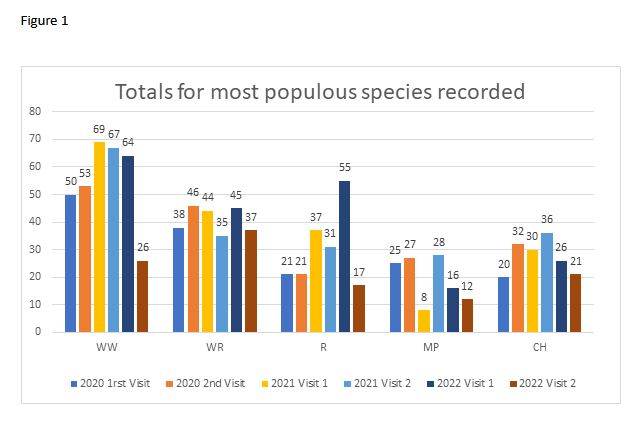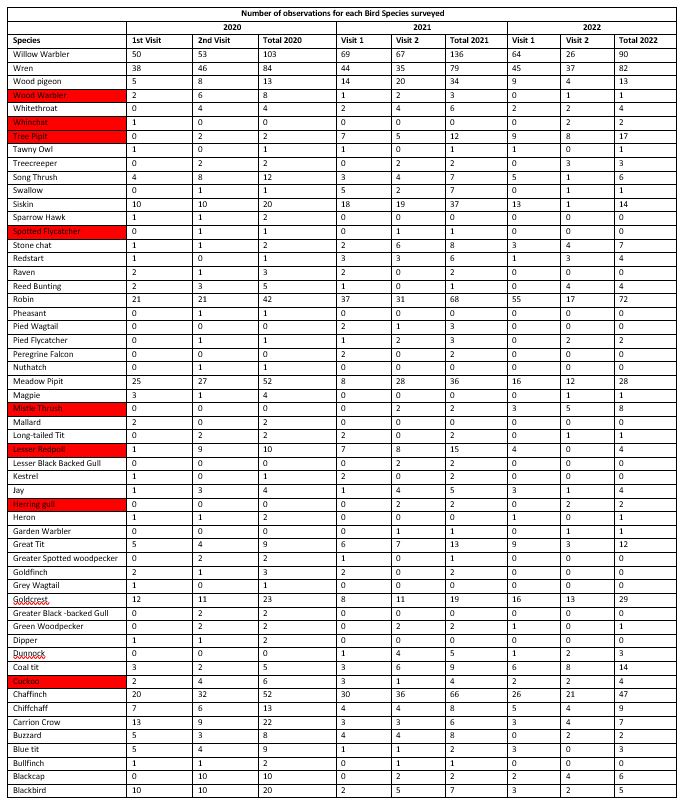Breeding Bird Survey: Summary 2020-2022
Introduction
The survey aims to provide a baseline monitoring of bird species across the Restoring Hardknott Forest (RHF) site. In the short term, this helps us understand the variety of species present and inform management activities that may affect them. Longer term, changes in species abundance and distribution may be seen as the habitat assemblage changes across the site. Therefore, this summary focuses on the relationship between the bird species recorded at RHF and their habitats. Some attention is given to species of conservation concern with International Union for Conservation of Nature (IUCN) red listed species highlighted.
Method
The methodology is based on an extended version of the British trust for Ornithology’s Breeding Bird Survey method to cover more of the site. There are two survey periods, an early visit in late April and a late breeding season survey, in early June. Three transect lines are walked, one the first day, two the next. Starting at approximately 8am and finishing by noon. We record: all birds identified within a transect line section; the distance category from the transect line; the identification method (visual or call heard, or song heard; the section completion and section elapsed time. Juvenile birds from that breeding year are not counted. This survey method was adopted as it provides good coverage of the site’s habitats and is effective at surveying small passerines (songbirds) during their breeding season though other bird species may be more easily detected and accurately assessed by other methods.
Results and Discussion
The number of bird species surveyed over the last three years ranged from 39 to 48 with a total of 55 recorded over the 3 years (table 1).

The variation in species recorded may be due to several factors. The decrease in bird species in 2022 is likely due to poor weather conditions. Fewer raptors observed to previous years that were known to be present from observations outside of the survey time, and certain river dwelling species were also not encountered (mallard, dipper etc.). With only a short time spent near the river Duddon the chance of observing these species is rather small. Point surveys may yield higher numbers of raptors or birds of a contained habitat and may be necessary if a particular species’ abundance was of concern.
Surveyor experience has also affected the accuracy of the results. Garden warblers were observed in 2021 which were likely present in 2020 but recorded as blackcap, which has a very similar song. Similarly, the increased number of tree pipits recorded in 2022 was likely due to a focussed effort to distinguish the species from meadow pipits as tree pipits are an ICUN red listed species. However, these errors will hopefully be minimal and contained to species that are difficult to identify. Continued monitoring as part of a longitudinal study would correct any major discrepancies in breeding bird species identified and begin to show population abundance trends across the site.
The five most common bird species recorded were willow warbler, wren, robin, meadow pipit and chaffinch (Tables 2 & 3). Willow warblers were the most common, making between 18-21% of all birds recorded each year (table 2 and figure 1) likely due to the large areas of small trees without a closed canopy. Wrens, robins and chaffinches can be considered habitat generalists and are found in different habitats across the site contributing to their high abundance. Meadow pipits are grassland and moorland specialists, utilising the more open areas.


These five species make up 58-62% of all birds observed during the three study years (table 2). The proportion these species contribute to the total birds observed seems unlikely to change significantly whilst the main habitat structures of conifer, clearfell and young broadleaf remain prevalent but as the forest matures continued monitoring may show other woodland specialists increase in abundance.
Some birds of conservation concern were recorded with seven species listed on the ICUN red list reported and one, the herring gull, observed flying in the locality (Table 3). The presence of these species is indicative of the importance of the habitats present at RHF but also may point to where a key habitat is limited. For example, tree pipit and spotted flycatchers require mature broadleaf woodlands with suitable nesting holes with clearings and woodland edges to feed in whilst wood warblers prefer closed canopy sessile oak or beech woods and are therefore rather rare at RHF. In due course these birds may well spread across the site as established woodland matures, but this will likely depend on the current fragmented habitats remaining suitable for them.
Table 3: Total for each bird species surveyed
Click here to see this table as a pdf.

Species highlighted in red are from the ICUN’s red list. (List sorted into reverse alphabetical order to place willow warbler and wren at the top as these are of interest being the most numerous and widely distributed species).
Some bird species, in particular winter migrants, are known to be present at RHF but have not been recorded during the surveys (Table 4)
Table 4: Incidental bird list for species seen outside of survey period

Looking Forward
As the habitat composition changes across the site, the distribution of bird species will likely reflect these changes. For example, birds that currently utilise the remaining plantation and dense regenerated conifers may be succeeded by open ground specialists before regeneration or planted broadleaved trees lead to these then being more attractive to scrub and young woodland preferring bird species (Figure 2).
Figure 2: Examples of bird species found as an area progresses through habitat types

It must be remembered that species currently found in conifer plantations have not evolved alongside these trees and may be present due to a lack of other woodland habitats. Hopefully with the phased approach to conifer removal and the restoration of other habitats at a landscape level, a more complex vegetation assemblage will establish than the simplistic progression shown in figure 2. This increased complexity will hopefully provide suitable habitat for the extant bird species found at RHF, and maybe provide emerging niches for new ones. The annual breeding bird survey has established a baseline of species abundance across the site. The next step is to integrate this with habitat mapping, so changes in distribution across the site can be assessed as work continues.
Many thanks to Craig Holden for all his work setting up our breeding bird survey, and for this analysis.
